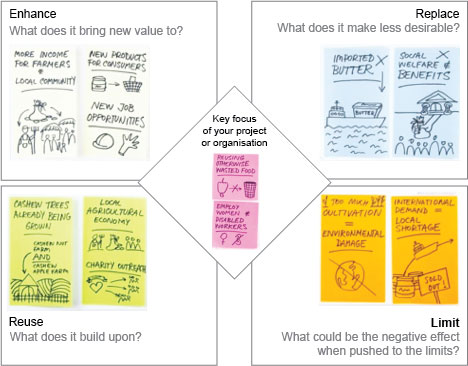3.1 Case study: fruit in West Africa
Case Study 3 summarises how the Evidence Planning Tool was used by a fruit company in West Africa.
Case Study 3: Evidence planning for decision making in West Africa
Randa is the chief executive of a fruit company in West Africa. She saw commercial potential when she learned that local farmers produced cashew nuts for export, but did nothing with the fruit from the cashew trees. Her company began to produce butter made from cashew apples. The business grew fast and Randa wanted to be clear about the wider effects of the company’s work.
Using the Evidence Planning Template, Randa looked at the impact of this work from different points of view. She began by filling out the main focus of her company, which was to employ women and disabled workers to repurpose otherwise wasted food. The four boxes around her key focus helped Randa to reflect on the key changes that her work could make in the agricultural sector, as well as the impact it could have on society.
She thought about what her company’s offering enhanced. She identified:
- more income for farmers and the local community
- new products for consumers
- new job opportunities.
Then she thought about what it replaced:
- imported butter
- social welfare benefits.
Next, she thought about what it limited:
- international demand could lead to local shortages
- over-cultivation could cause environmental damage.
Finally, she thought about what it reused or built on:
- cashew trees were already grown for nuts, but now fruit was also harvested
- the work added to the local agricultural economy
- the work provided charity outreach.
Looking ahead, Randa could see the wider impact of her company on local farmers, the community, the environment and the economy. This is shown in Figure 4.

Randa could also see how this might change in the future. She now has a better understanding of her company’s strengths and weaknesses and where she can improve. Randa’s completed template is shown in Figure 5.
3 Applying the Evidence Planning Tool

